Cervical Cancer Treatment
Verified By: Dr. Boman Dhabhar (Oncologist in Fortis Hospital Mulund)
What is Cervical Cancer?
Cervical cancer occurs in the cells of the cervix which is the lower part of the uterus and connects to the vagina. Cervical cancer is caused due to infection with human papillomavirus (HPV) and starts with the growth of abnormal cells that are not cancerous. The appearance of these precancerous cells is the first evidence of cancer which develops years later. Cervical cancer grows slowly, so there is enough time to find and treat it before it causes serious problems. They can be detected with a Pap test. This cancer affects the deeper tissues of the cervix and can spread to other parts of the body (metastasize), generally to the lungs, liver, bladder, vagina, and rectum. Cervical cancer is the second most common type of uterine cancer worldwide.
If precancerous cells on the surface of the cervix multiply abnormally and spread deeper into the cervix, or to other tissues or organs, the disease is called cervical cancer, or invasive cervical cancer. Cervical cancer can cause abnormal vaginal bleeding and discharge and pain during sex, but most women do not notice signs or symptoms of cervical cancer until it has grown into tissues beyond the cervix.
How does Cervical Cancer develop?
The human papillomavirus (HPV) is responsible for warts in both men and women, including genital warts, called condyloma acuminate. These are generally benign, or noncancerous. Most HPV infections disappear spontaneously, being overcome by the body’s immune system. There are over a hundred types of HPV, but only a few are cancerous, and only the persistent infection with certain types of HPV can cause cervical cancer.
What are the Cervical Cancer Types?
There are different types of cervical cancer including:
- Squamous cell carcinoma – This type forms in the lining of your cervix and it is found in 90% of the cases. This begins in the cervical cells closest to the vagina.
- Adenocarcinoma – This type forms in the cells producing mucus. This begins in the cervical cells closest to the uterus.
- Mixed carcinoma – This has features of both squamous cell and adenocarcinoma.
What are the Cervical Cancer Symptoms?
Early-stage cervical cancer does not produce any signs or symptoms. However, the signs and symptoms of more-advanced cervical cancer will include:
- Abnormal bleeding and increased vaginal discharge that may be heavy and have a foul odour
- Vaginal bleeding after intercourse or between periods and after menopause
- Watery, bloody vaginal discharge and pain during urination
- Pelvic pain or pain during intercourse.
What are the Risk Factors for Cervical Cancer?
You may be at a higher risk of cervical cancer:
- If you started having sex before the age of 16
- If you have multiple sexual partners
- If you take birth control pills, especially for more than 5 years
- If you smoke cigarettes
- If you are having a weakened immune system
- If you are having sexually transmitted infections such as HIV/AIDS, they increase your risk of HPV.
How is Cervical Cancer Diagnosed?
If there are signs and symptoms of cervical cancer, or if the Pap test reveals abnormal cells, a doctor may recommend additional tests to diagnose cervical cancer.
Diagnosing cervical cancer involves:
- Colposcopy – If cervical cancer is suspected, your doctor is likely to start with a thorough examination of your cervix. A special magnifying instrument called a colposcope will be used to check for abnormal cells.
- Biopsy – During the colonoscope examination, your doctor is likely to take a sample of cervical cells (biopsy) for laboratory testing.
To obtain tissue, your doctor may use:
- Punch biopsy involves using a sharp tool to pinch off small samples of cervical tissue.
- Endocervical curettage uses a small, spoon-shaped instrument known as a curet or a thin brush to scrape a tissue sample from the cervix.
- Cone biopsy is where the doctor takes a small, cone-shaped section of abnormal tissue from the cervix for examination.
- Loop electrical excision procedure (LLETZ): Diathermy using a wire loop with an electric current helps to remove abnormal tissue. It is then sent to the lab for checking.
If your doctor determines that you have cervical cancer, you should have further tests to determine the extent (stage) of your cancer such as X-ray, CT, MRI and positron emission tomography (PET) to help your doctor determine whether your cancer has spread beyond your cervix.
What are the Stages of Cervical Cancer?
After you have been diagnosed, your doctor will assign your cancer a stage. The stage will tell whether cancer has spread, and how far it has spread. Staging your cancer can help your doctor to find the right treatment for you. Cervical cancer has four stages:
- Stage 0: Precancerous cells are present.
- Stage 1: The cancer is small. It may have spread to the lymph nodes but it has not spread to other parts of your body.
- Stage 2: The cancer is larger so it may have spread outside the uterus and cervix or to the lymph nodes. It still has not reached other parts of your body.
- Stage 3: Cancer has spread to the lower part of the vagina or to the pelvis and may be blocking the ureters, which are tubes that carry urine from the kidneys to the bladder. It has not spread to other parts of your body.
- Stage 4: Cancer may have spread outside the pelvis to organs like your lungs, bones, or liver.
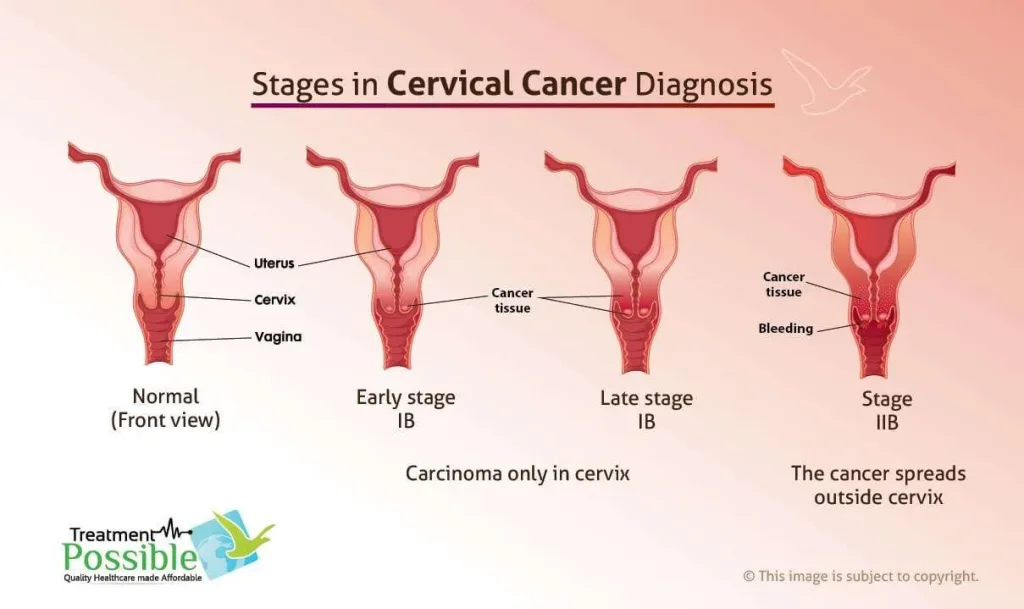
What are the Treatment options for Cervical Cancer?
The treatment plan will depend on a number of factors that include the type and stage of disease, the woman’s age and her general health.
Cervical Cancer Surgery:
The purpose of this surgery is to remove as much of the cancer as possible but sometimes the doctor removes just the area of the cervix which contains cancer cells. There are different types of surgery to treat cervical cancer and the type suitable for you will depend on the extent of the spread of cancer. Surgery is preferred at cervical cancer stage 1. In case, the cancer has not spread beyond the cervix, one of the following surgical procedures can be performed:
Conization for Cervical Cancer:
It is used in micro-invasive cancer which can only be seen under a microscope. It is like a cone biopsy that removes very early stages of cervical cancer. This procedure will involve cutting away a cone-shaped piece of cervical tissue, but leaving the rest of the cervix intact. This option makes it possible for you to consider becoming pregnant in the future.
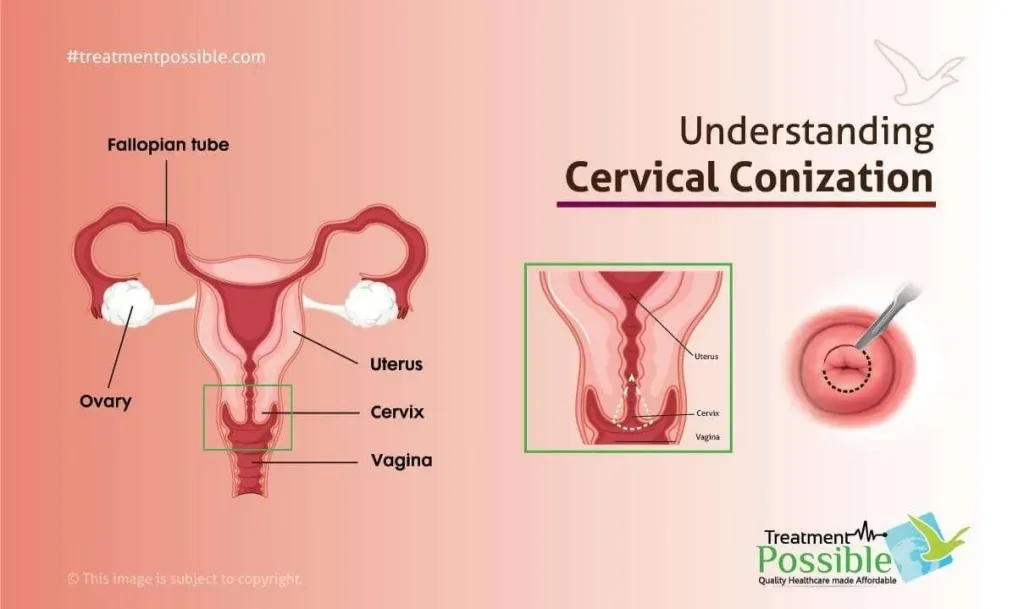
LEEP for Cervical Cancer:
It is the use of small wire passing electric current to target the cancer tissue and remove it. It is also used in micro-invasive cancers.
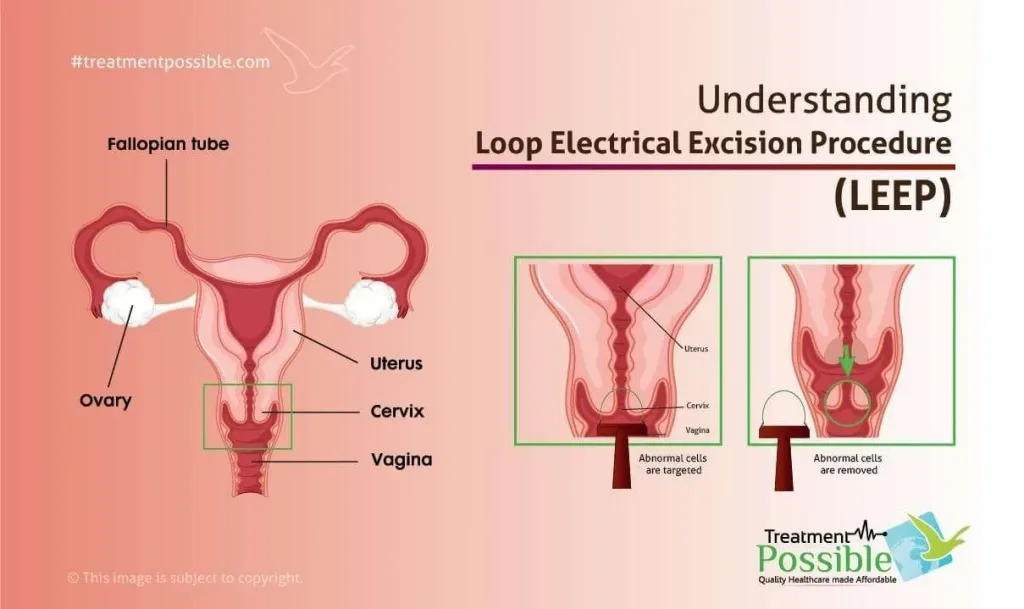
Radical Trachelectomy for Cervical Cancer:
Early-stage cervical cancer can be treated with a radical trachelectomy procedure. In this surgical procedure, only the cervix is removed but the uterus is not. It is done for those patients who want to become pregnant. In this procedure, all the pelvic lymph nodes are removed.
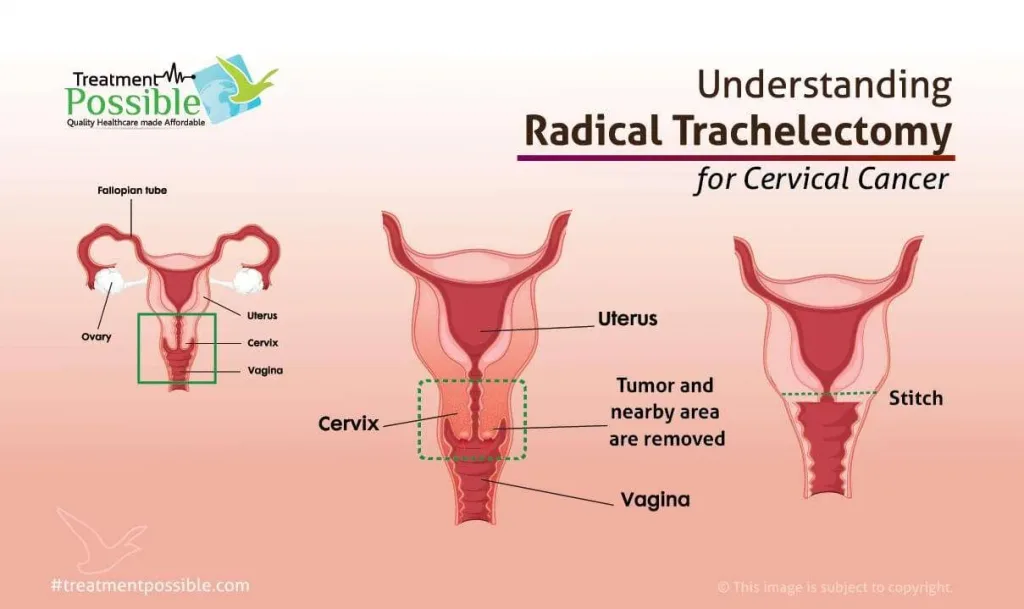
Hysterectomy for Cervical Cancer:
It can be either simple or radical. In the case of less intensive cancers, simple hysterectomy i.e. removal of uterus and cervix is done. But, in cases of higher-grade cancers, a radical hysterectomy procedure is the one in which the uterus, cervix, upper vagina and tissue around the cervix are removed. In these cases, a lymph node dissection in the pelvic area is also performed which means all the lymph nodes in the pelvic region are removed. Sometimes bilateral salpingo-oophorectomy is also required along with hysterectomy. Here, both the ovaries and fallopian tubes are removed. A hysterectomy cures early-stage cervical cancer and prevents recurrence. But after removing the uterus, it is not possible to become pregnant.
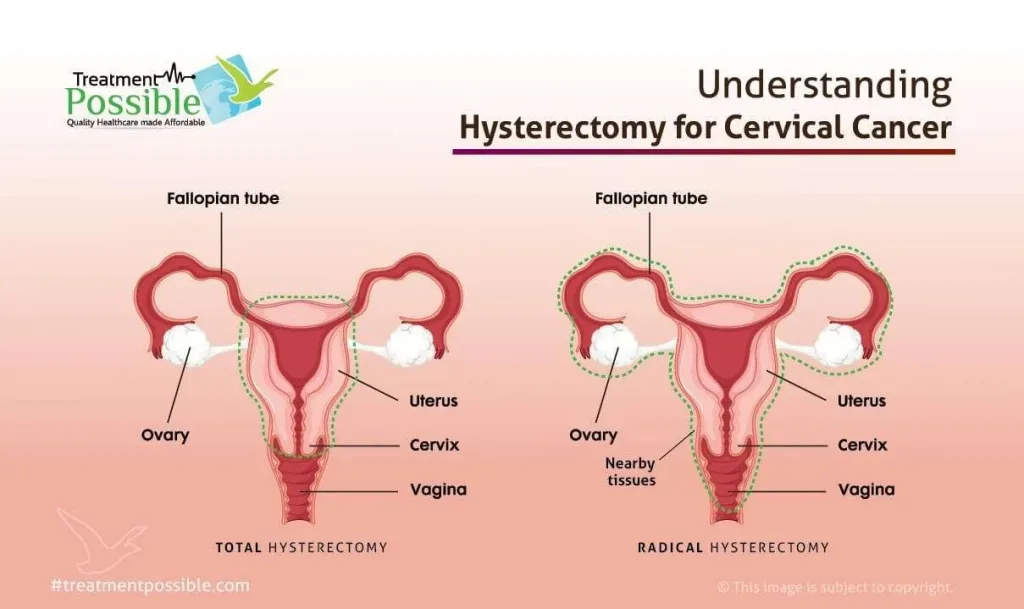
In the patients where cervical cancer has already spread beyond the cervix, the following procedure may be used:
Pelvic exenteration: It involves the removal of vagina, uterus, lower colon, rectum or bladder. All these if cancer has spread to these organs. It is mostly done in recurrent cases of cancer.
All of these surgical procedures may affect the sexual health of women. So, before going for any surgery, you should clear all your doubts with the doctor.
Radiation Therapy for Cervical Cancer Treatment
A radiation oncologist plans the radiation therapy schedule for the patient. It can be planned before surgery to shrink the size of cancer before its surgical excision. It is also continued after the surgery. Most commonly external beam radiation therapy is used. Internal therapy includes Brachytherapy in which the radiation is given by inserting a radiation-emitting device through the vagina.
- Radiation is often combined with chemotherapy as the primary treatment for locally advanced cervical cancers.
- It can also be used after surgery if there is an increased risk of recurrent cancer.
- External radiation aims a beam of radiation at your pelvis which takes only a few minutes, 5 days a week for 5 to 6 weeks.
- Internal radiation which is also called implant radiation or brachytherapy can also be delivered inside the body using a metal tube placed in the uterus or vagina. The implant puts cancer-killing rays near the tumor and spares most of the healthy tissue around it.
- Radiation therapy might cause menopause, so if you want to consider becoming pregnant after radiation treatment, ask your doctor about ways to preserve your eggs before treatment starts.
The approximate cost of Radiotherapy for cervical cancer treatment is USD 2500.
Chemotherapy for Cervical Cancer Treatment
Uses medicines to kill the cancer cells and is usually given before the surgery to reduce the size of the cancer. It is also continued after surgery in some cases. These medications do not differentiate between the normal and cancer cells. So, the most common side effects are Temporary hair loss, Taste sensation loss and Nausea and vomiting.
- Chemotherapy can be used alone or can be combined with radiation therapy.
- Chemotherapy can also be used before surgery to shrink cancers and make them easier to remove.
- In advanced cervical cancer, chemotherapy can be used to relieve pain.
The approximate cost of Chemotherapy for cervical cancer treatment per cycle is USD 450.
**The treatment options available for cervical cancer treatment include hormonal therapy, biological therapy, targeted therapy etc.
Want more clarification about medical expense & treatment plan?
Consult an Experienced Doctor online for free and plan your treatment In India
What is the Cost of Cervical Cancer Treatment in India?
The average cost of treatment for cervical cancer in India is $4500. The low cost of treatment in India is due to the cheap infrastructure while the quality of medical services is excellent. Treatment in India is 80% – 90% cheap than most of the western countries!
The table below gives detailed information about the cost of treatment for cervical cancer:
| Treatment Options | Cost (USD) |
|---|---|
| Pet Scan | $250 |
| Chemotherapy | $300 – $680 (per cycle) |
| Radiation Therapy | $2800 – $3800 |
| Brachytherapy | $800 |
| Surgery | $3800 |
When planning your treatment in India it is necessary to consider additional costs associated with the accommodation such as the hotel and food. We also provide service apartments for our patients as it is cheaper than hotels and more convenient. Due to our decade-old association with the best hospitals and surgeons in India, we ensure that you get the best medical services at an affordable cost. You can contact us by filling the form below or Whatsapp Us.
What do you need to do to Prepare yourself for Cervical Cancer Treatment ?
- The first and foremost thing that you need to do is keep yourself well informed about your cancer, this improves your quality of life as this can make the disease seem less mysterious and frightening. Information from your doctor and other credible sources can be very helpful in this respect.
- When a person is diagnosed with cancer it hurts their emotional state, so you need to prepare yourself mentally and emotionally. This can be done by being transparent with your family and friends about how you feel, the problems you have been facing so they can help you in a better way. And as a peer or a family member of the patient, you must support them at all times by listening to them patiently as they are emotionally compromised.
- You can avail services of a counsellor or attend group therapies consisting of cancer survivors who share their past experiences.
- Writing down about your queries, problems, new symptoms, any physical changes, medications, past medical reports and other important things will help you to clearly express yourself to the doctor.
